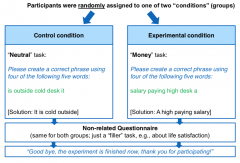![]()
![]()
![]()
Use LEFT and RIGHT arrow keys to navigate between flashcards;
Use UP and DOWN arrow keys to flip the card;
H to show hint;
A reads text to speech;
22 Cards in this Set
- Front
- Back
|
Why do we need experimental research? |
Descriptive studies describes how people think, feel and behave Correlational studies see whether certain variables are related to one another |
|
|
How can you complete rule out non spuriousness? |
Well-run experiment |
|
|
What is experimental research? |
Experimental research allows us to know the cause of behaviour Manipulation of one or more independent variables Measure changes in other dependent variables Controlling the influence of extraneous control variables |
|
|
How is the money experiment structured? |

|
|
|
What basic ingredients are necessary for an experiment? |
Manipulation of one or more independent variables(must hat two or more levels) Dependent variables: response being measured, typically participants thoughts, feelings, behaviour or physical reaction If experiment uses deception, it has to be fully described |
|
|
What are the 5 essential properties of an experiment? |
Control, randomization, systematic manipulation, descriptiveness, reproducibility |
|
|
Explain control |
Control of extraneous (potentially confounding) variables -->eliminated through randomized allocation of participants, statistical control of extraneous variables and holding other variables constant |
|
|
What are confounding variables? |
Extraneous variable affecting the variables being studied-->results do not reflect actual relationship between variables |
|
|
Explain randomization |
Participants have equal probability of being in any experimental condition-->confidence that groups are roughly equivalent at the beginning of the study |
|
|
Explain systematic manipulation |
Independent variables are manipulated in a systematic manner Many studies fail because of unsuccessful manipulation Can be checked through a separate pilot test or controlled by manipulation check |
|
|
Explain descriptiveness |
Researcher need to be able thoroughly describe what exactly was done in the experiment |
|
|
Explain reproducibility |
Others need to be able to repeat the experiment-->same result, if not try to identify the cause why it could not be replicated |
|
|
Which threats are there to internal validity? |
Failed random assignment, different drop-out rate, extraneous events, experimenter expectancy |
|
|
How can researcher avoid bad internal validity? |
Double-blind procedures: participants and experimenter both don’t know which condition the participants is in |
|
|
What are the trade-offs between internal and external validity? |
Through tight control (internal validity) an experiment might become to unique (less like the settings of realityàlower external validity) |
|
|
What other types of experiments are there? |
Conjoint experiment, natural experiment and quasi experiment |
|
|
What is a conjoint experiment? |
Objects are dissected into discrete dimension thought to be essential to utility of use Define values for each dimension Derive reduced set of “cards” to capture values on each dimension Ask people to rank cardsàthen only one independent variable is going to be changed and tested again Context: investment, purchasing, evaluation of teams |
|
|
What is a natural experiment? |
One group of subjects is exogenously treated by a chance event, or at least something outside their control; another, similar group is not |
|
|
What is a quasi-experiment? |
Similar to natural experiment, variable do not “occur naturally” but selected |
|
|
Which 3 dimensions are there for experimental designs? |
Number of independent variables number of dependent variables (univariate vs multivariate) how is measurement repeated (between subject(comparison across groups) vs within subjects(each person is tested multiple times) |
|
|
what is a cool method? |

Simple analysis of the resulted distribution of the controlled group and experiment group at the mean |
|
|
What does the t-test allow for the cool method? |
It checks whether the mean of one variable is equal to certain value (often 0), the difference between the means of two variable is significant |

